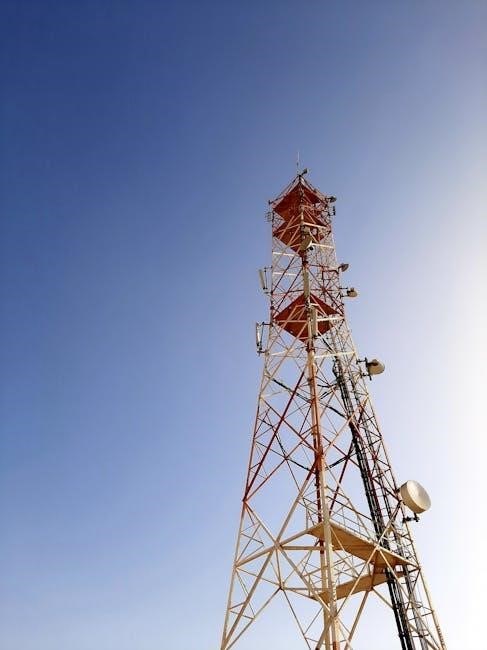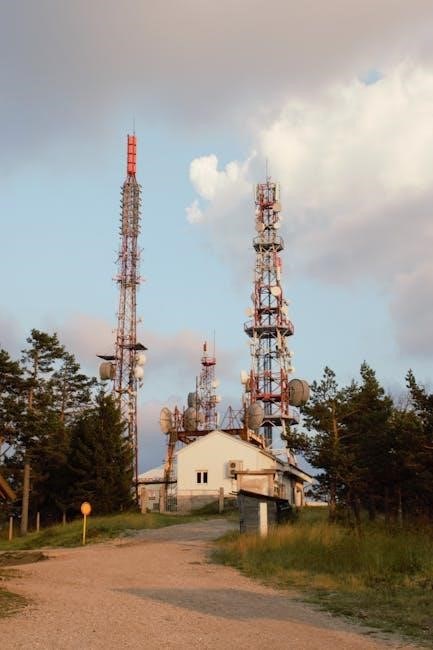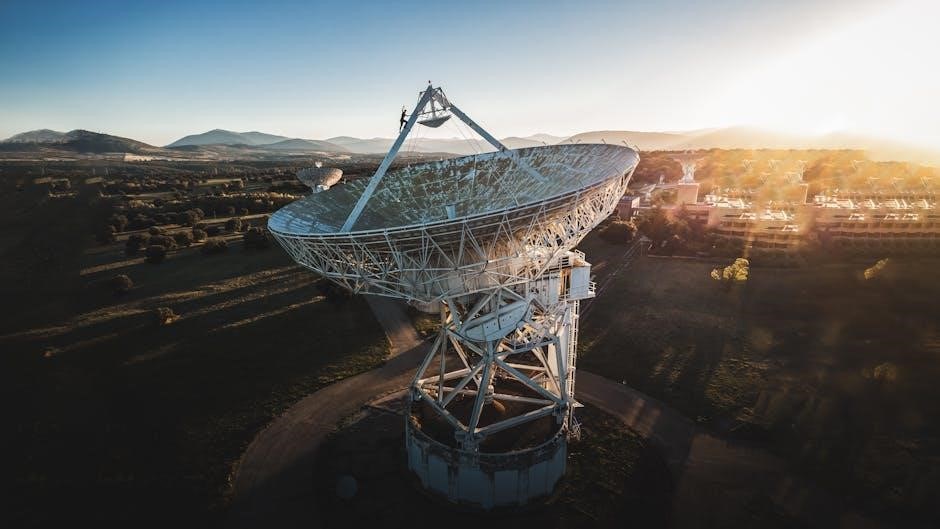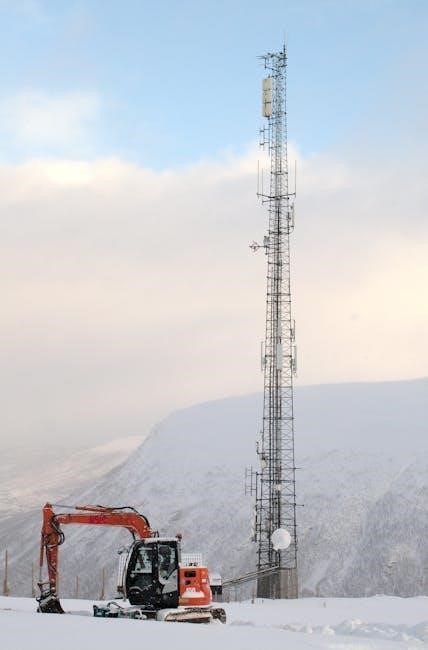Remote start systems allow drivers to start their vehicle’s engine from a distance‚ offering convenience and comfort‚ especially in extreme weather conditions. These systems are increasingly popular but present unique challenges when installed in manual transmission vehicles due to the need for clutch engagement and neutral gear verification. While traditionally designed for automatic transmissions‚ advancements in technology now enable remote start installation on manual vehicles with specialized safety features and automated systems to ensure proper operation and prevent accidental movement. This section explores the fundamentals of remote start technology and its application to manual transmission cars.
1.1 What Is a Remote Start System?
A remote start system is a device that allows a vehicle’s engine to be started from a distance using a remote control. This technology enhances convenience‚ enabling drivers to warm up or cool down their car before entry. While traditionally more common in automatic vehicles‚ advancements now enable compatibility with manual transmissions‚ addressing challenges like clutch engagement and neutral gear verification. Modern systems integrate safety features to prevent accidental starts‚ ensuring the vehicle remains secure and stationary when activated remotely.
1.2 Benefits of Remote Start Technology
Remote start technology offers unparalleled convenience‚ allowing drivers to start their vehicle from a distance. This feature is especially beneficial in extreme weather‚ enabling preheating in winter or cooling in summer. It enhances security by ensuring the vehicle remains locked while running. For manual transmission vehicles‚ modern systems include safeguards to prevent accidental movement‚ providing peace of mind. Remote start also saves time and adds comfort to the driving experience‚ making it a valuable upgrade for both daily commutes and long trips.
1.3 Overview of Manual Transmission Vehicles
Manual transmission vehicles require driver engagement through a clutch pedal and gearshift‚ offering precise control over gear changes. Unlike automatics‚ manuals demand active participation‚ making them less compatible with remote start systems. The clutch must disengage before starting‚ and the vehicle must be in neutral to prevent unintended movement. Despite these challenges‚ manual transmissions are favored for their driving experience‚ fuel efficiency‚ and cost-effectiveness. Understanding their unique mechanics is crucial when considering remote start installation.

Can You Install a Remote Start on a Manual Transmission Vehicle?
Yes‚ remote starts can be installed on manual transmission vehicles‚ but they require additional safety features like a neutral safety switch and an automated clutch system to prevent accidental movement and ensure proper operation. These systems must verify the vehicle is in neutral before starting‚ making installation more complex than for automatics. Proper setup by a professional is essential to maintain safety and functionality.
2.1 Understanding the Challenges of Manual Transmissions
Manual transmissions present unique challenges for remote start installations due to the clutch pedal’s role in starting the vehicle. Unlike automatics‚ manuals require disengaging the clutch to start the engine. This necessitates specialized systems to ensure the vehicle remains stationary and in neutral gear during remote starting. Without proper safety mechanisms‚ accidental vehicle movement could occur. Additionally‚ the lack of a neutral safety switch in some manuals complicates the process‚ requiring advanced solutions to maintain safety and functionality. These challenges make manual vehicles more complex for remote start installations.
2.2 The Role of the Clutch in Remote Starting
The clutch plays a critical role in remote starting for manual transmission vehicles. In a manual car‚ the clutch pedal must be pressed to start the engine‚ as it disconnects the engine from the transmission. Without proper automation‚ remote starting isn’t feasible. Specialized systems are required to simulate clutch engagement‚ ensuring the vehicle doesn’t move when started remotely. These systems must precisely control the clutch to avoid accidental vehicle movement‚ making remote start installations more complex for manual vehicles compared to automatics. Proper clutch handling is essential for safe operation.
2.3 The Need for Additional Safety Features
Remote starting a manual transmission vehicle requires extra safety measures to prevent accidental movement. A neutral gear verification system is essential to ensure the vehicle doesn’t start in gear. Additional features like a brake pedal or clutch monitor can prevent unintended engine engagement. An emergency shut-off mechanism is also crucial to stop the engine if the vehicle starts moving unexpectedly. These safety features work together to mitigate risks and ensure safe operation‚ making remote start installation viable for manual vehicles. Proper installation is critical to avoid accidents.

Technical Requirements for Remote Start Installation
Remote start systems for manual vehicles require specific technical adaptations‚ including neutral gear verification and automated clutch engagement mechanisms to ensure safe and proper engine activation.
3.1 Compatibility of Remote Start Systems with Manual Transmissions
Remote start systems can be compatible with manual transmissions‚ but they require additional components to ensure safe operation. These include specialized bypass modules and clutch engagement sensors to prevent accidental movement. The neutral safety switch must be engaged‚ and the vehicle must confirm it is in neutral gear before starting. Modern systems often integrate automated clutch mechanisms to simulate clutch engagement‚ allowing the engine to start without manual input. This ensures functionality while maintaining safety standards for manual vehicles.
3.2 The Role of Neutral Safety Switches
A neutral safety switch is crucial for remote start systems in manual vehicles‚ ensuring the car is in neutral gear before ignition. This prevents accidental starts in gear‚ reducing the risk of unintended movement. The switch monitors the gear position and only allows the engine to start when neutral is confirmed. In manual transmissions‚ this feature is essential to maintain safety and prevent potential accidents caused by improper gear engagement during remote starting.
3.3 The Importance of an Automated Clutch System
An automated clutch system is vital for remote starting a manual transmission vehicle. It enables the clutch to engage and disengage electronically‚ allowing the engine to start without driver input. This system ensures smooth transitions and prevents stalling‚ making remote starts feasible. Without it‚ manual vehicles cannot safely remote start‚ as the clutch would remain depressed‚ risking unintended movement or engine stall. This technology bridges the gap between convenience and functionality for manual transmission owners seeking remote start capabilities.

Safety Considerations for Remote Start on Manual Vehicles
Remote starting manual vehicles requires failsafes to prevent accidental movement. Ensuring the car is in neutral‚ the clutch disengaged‚ and installing emergency shut-offs is critical for safety.
4.1 Preventing Accidental Vehicle Movement
Preventing accidental movement is critical when installing a remote start on a manual transmission vehicle. The system must ensure the vehicle is in neutral gear and the clutch is disengaged before starting. Advanced safety features‚ such as neutral gear verification and clutch monitoring‚ are essential to prevent unintended movement. Additionally‚ fail-safes like automatic shut-off if the vehicle isn’t in neutral further enhance safety. These mechanisms are vital to avoid accidents and ensure the system functions safely and reliably.
4.2 Ensuring the Vehicle Is in Neutral Gear
Ensuring the vehicle is in neutral gear is a critical safety measure for remote start systems in manual transmission vehicles. Modern remote start systems often integrate with the vehicle’s neutral safety switch to verify the gear position before engine ignition. This prevents accidental movement‚ as the system will not activate if the vehicle is not in neutral. Additional sensors and automated clutch systems can further enhance this functionality‚ ensuring the vehicle remains stationary during remote starting. This step is essential for maintaining control and safety.
4;3 Implementing Fail-Safes and Emergency Shut-Offs
Implementing fail-safes and emergency shut-offs is crucial for remote start systems in manual vehicles. These features ensure the engine shuts off immediately if the vehicle starts moving or if an unauthorized gear shift occurs. Emergency shut-off buttons or panic functions can be activated remotely to disable the engine. Advanced systems monitor gear position and vehicle movement‚ adding an extra layer of safety. These fail-safes prevent accidental vehicle operation and provide peace of mind for vehicle owners.

Legal and Insurance Implications
Installing a remote start on a manual transmission may have legal and insurance implications. Check local laws regarding remote start systems and ensure your insurance covers modifications.
5.1 Legal Restrictions on Remote Start Systems
Legal restrictions on remote start systems vary by jurisdiction. Some regions prohibit remote starting of manual transmission vehicles due to safety concerns. Ensure compliance with local laws‚ as unauthorized modifications can lead to fines or insurance issues. Certain states require specific certifications for remote start installations. Always verify legal requirements before proceeding with installation to avoid penalties and maintain insurance validity. Consulting local authorities ensures adherence to regulations and prevents potential legal complications.
5.2 Insurance Requirements for Modified Vehicles
Installing a remote start system on a manual transmission vehicle may require notifying your insurance provider. Modified vehicles often need special coverage‚ and failure to disclose aftermarket installations can invalidate policies. Insurance companies typically require proof of professional installation and system certification. Check with your provider to ensure compliance‚ as non-approved modifications can lead to denied claims. Proper documentation and adherence to insurance guidelines are essential to maintain valid coverage and avoid potential issues.
5.3 Liability Concerns with Remote Start Installations
Installing a remote start system on a manual transmission vehicle raises liability concerns. Improper installation or system failure could lead to accidental vehicle movement‚ causing damage or injury. Vehicle owners and installers may be held liable if negligence is proven. Ensuring proper installation by certified professionals and adhering to safety protocols is crucial to minimize risks. Additionally‚ warranties and service agreements should be reviewed to understand coverage in case of malfunctions or related incidents.

Cost Considerations and Installation
Remote start systems for manual vehicles typically cost between $300 to $1‚500‚ depending on features and complexity. Installation requires specialized tools and expertise‚ adding labor costs.
6.1 Cost of Remote Start Systems for Manual Vehicles
Remote start systems for manual vehicles typically range from $300 to $1‚500‚ depending on features and complexity. Basic models with essential functions cost less‚ while advanced systems with additional features like smartphone integration or GPS tracking are pricier. The cost also varies by brand‚ installer‚ and compatibility requirements. Manual vehicles often need extra components‚ such as bypass modules or sensors‚ increasing the overall expense. Labor costs for installation add to the total‚ making it essential to research and compare options.
6.2 Labor Costs for Professional Installation
Labor costs for remote start installation on manual vehicles vary based on complexity and technician expertise. Expect to pay between $100 and $300 for labor‚ depending on the system’s requirements. Manual transmissions often demand additional time due to clutch and neutral safety switch configurations. Certified installers may charge more for their specialized knowledge. It’s essential to request detailed quotes from reputable professionals to ensure all factors are accounted for‚ avoiding unexpected expenses. Additional fees may apply for specialized tools or advanced features.
6.3 DIY Installation Risks and Challenges
DIY installation of a remote start on a manual vehicle poses significant risks‚ including improper clutch and neutral safety switch configurations. Incorrect wiring can damage the vehicle’s electrical system or disable essential safety features. Without specialized tools and expertise‚ enthusiasts may inadvertently create security vulnerabilities or cause unintended engine behavior. Additionally‚ DIY installations often void manufacturer warranties and may not meet legal or insurance requirements. The complexity of manual transmission systems makes professional installation highly recommended to ensure reliability and safety.

Reliability and Performance
Remote start systems on manual vehicles are reliable and efficient with proper installation and advanced automation‚ ensuring smooth operation and safety.
7.1 How Reliable Are Remote Start Systems in Manual Vehicles?
Remote start systems in manual vehicles are generally reliable when installed correctly‚ but their performance depends on factors like clutch automation and neutral gear verification. Proper installation ensures smooth operation‚ while poor setup can lead to issues like accidental movement or failure to start. Modern systems often include advanced safety features to prevent mishaps‚ making them more dependable. However‚ the complexity of manual transmissions can introduce unique challenges‚ requiring careful calibration to maintain reliability and performance. Regular maintenance is essential to uphold functionality.
7.2 Factors Affecting System Performance
The performance of remote start systems in manual vehicles can be influenced by several factors‚ including clutch automation accuracy‚ neutral gear verification‚ and environmental conditions. Weather extremes‚ battery health‚ and signal strength also play a role. Additionally‚ improper installation‚ such as poor wiring or misconfigured sensors‚ can lead to malfunctions. The quality of the remote start unit and its compatibility with the vehicle’s electrical system are critical. Regular software updates and maintenance are essential to ensure optimal functionality and address potential issues.
7.3 Common Issues and Troubleshooting Tips
Common issues with remote start systems in manual vehicles include failure to engage the clutch‚ inaccurate neutral gear detection‚ and unreliable signal transmission. Troubleshooting often involves checking wiring connections‚ ensuring proper clutch calibration‚ and verifying sensor functionality. Additionally‚ software glitches may require updates or resets. Users should consult their system’s manual and consider professional assistance if problems persist. Regular maintenance and thorough testing can help prevent these issues‚ ensuring seamless operation and driver convenience.

Manufacturer-Specific Solutions
Certain manufacturers offer factory-installed remote start systems designed for manual transmissions‚ while others partner with aftermarket brands to provide compatible solutions. These systems often include specialized features to address manual-specific challenges‚ ensuring safe and reliable operation. Compatibility varies by make and model‚ so consulting the manufacturer or a professional installer is recommended for optimal results.
8.1 Factory-Installed Remote Start Options
Some vehicle manufacturers offer factory-installed remote start systems for manual transmission cars‚ though availability is limited. These systems are engineered to address specific manual transmission challenges‚ such as clutch engagement and neutral gear verification. They often include advanced safety features to prevent accidental vehicle movement. However‚ compatibility varies by make and model‚ so checking the vehicle’s specifications or consulting the manufacturer is essential before installation. This ensures the system functions seamlessly with the manual transmission setup.
8.2 Aftermarket Solutions for Manual Vehicles
Aftermarket remote start systems for manual vehicles are available but require careful consideration. These systems often need additional components‚ such as bypass modules and clutch sensors‚ to ensure safe operation. They must account for manual transmission-specific challenges‚ like clutch engagement and neutral gear verification. While installation is possible‚ it’s more complex than for automatics‚ requiring expertise to prevent accidental vehicle movement. Aftermarket solutions can be effective but typically involve higher costs and complexity compared to factory-installed options. Professional installation is highly recommended.
8.3 Popular Brands and Their Compatibility
Several aftermarket brands offer remote start solutions for manual vehicles‚ with varying degrees of compatibility. Brands like Compustar‚ Viper‚ and Avital provide systems that can be adapted for manual transmissions with additional components. These systems often require clutch sensors and bypass modules to ensure safe operation. Compatibility varies by vehicle make and model‚ so it’s essential to consult with professionals to determine the best solution. Always check manufacturer specifications to ensure proper functionality and avoid voiding warranties.

User Experiences and Reviews
Users report mixed experiences with remote starts on manual vehicles‚ citing convenience and comfort as key benefits but noting challenges with installation complexity and reliability variations.
9.1 Real-World Feedback from Manual Vehicle Owners
Manual vehicle owners share diverse experiences with remote start installations. Many appreciate the convenience‚ especially in harsh weather‚ but highlight the need for professional installation to ensure safety and functionality. Some users report issues with system reliability and unexpected shutdowns‚ emphasizing the importance of compatible and high-quality components. Others praise the seamless integration of modern systems‚ noting improved comfort without compromising the driving experience unique to manual transmissions.
9.2 Success Stories and Lessons Learned
Many manual vehicle owners report successful remote start installations‚ praising the convenience and improved driving experience. Enthusiasts and everyday drivers alike highlight the benefits of preheating engines in winter or cooling vehicles in summer. Professional installations with compatible systems often yield the best results. Lessons learned include the importance of proper clutch and neutral safety integration‚ as well as regular system maintenance to ensure reliability. These success stories underscore the potential of remote starts on manual transmissions when done correctly.
9.3 Common Complaints and Misconceptions
Many manual vehicle owners express concerns about remote start compatibility‚ often believing it’s impossible or unsafe. A common misconception is that manual transmissions cannot support remote starts‚ though modern systems address this with specialized features. Some users report issues with accidental starts or false engagement‚ highlighting the need for precise installation. Others criticize the high costs and complexity of compatible systems. These concerns underscore the importance of understanding the unique requirements and limitations of remote start installations on manual vehicles.

Future of Remote Start Technology
The future of remote start technology promises seamless integration with smartphones and smart devices‚ enhanced security‚ and AI-driven automation for manual transmissions‚ ensuring convenience and safety.
10.1 Advances in Automation and Connectivity
Advances in automation and connectivity are revolutionizing remote start systems‚ enabling seamless integration with smartphones and smart devices. Smart systems now detect neutral gear automatically‚ ensuring safe starts for manual vehicles. Automated clutch systems and enhanced connectivity features‚ like geofencing and voice commands‚ are being developed. These innovations improve convenience and safety‚ allowing drivers to control their vehicles remotely with greater precision. Future updates may include predictive maintenance and energy optimization‚ further enhancing the user experience for manual transmission owners.
10.2 Integration with Smart Technology
Remote start systems are increasingly integrating with smart technology‚ enabling control via smartphones‚ smartwatches‚ and voice assistants like Siri or Alexa. Apps now allow users to start their car‚ check status‚ and receive real-time notifications. For manual vehicles‚ this integration requires advanced safety features to ensure the car is in neutral before starting. Future advancements may include smart home device compatibility and biometric authentication‚ making remote starts more convenient and secure for manual transmission owners. This seamless connectivity enhances user experience and accessibility.
10.3 Potential Innovations for Manual Vehicles
Future innovations may include advanced AI-driven systems that automatically detect neutral gear or clutch position‚ enabling smoother remote starts for manual vehicles. Biometric authentication could enhance security‚ ensuring only authorized users can activate the system. Additionally‚ integration with environmental sensors might prevent remote starts in unsafe conditions‚ such as inclines or obstructed areas. These advancements aim to bridge the gap between convenience and safety‚ making remote starts more accessible and reliable for manual transmission owners.
Remote start systems can be installed on manual vehicles with proper safety features and automated clutch systems‚ ensuring convenience and safety. Correct installation is crucial for reliability and performance.
11.1 Summary of Key Points
Remote start systems can be installed on manual transmission vehicles with specific modifications. Key considerations include neutral gear verification‚ automated clutch systems‚ and additional safety features. Professional installation is highly recommended to ensure reliability and prevent accidental movement. These systems offer convenience but require careful setup to maintain functionality and safety. Balancing technology with manual transmission specifics is essential for a successful installation‚ making remote starts a viable option for manual vehicle owners who prioritize ease and performance.
11.2 Final Recommendations for Manual Vehicle Owners
Installing a remote start on a manual transmission vehicle is possible with the right modifications. Owners should opt for systems with automated clutch control and neutral gear verification to ensure safety. Consulting a professional installer is crucial to avoid operational issues. Additionally‚ checking local legal restrictions and insurance requirements is essential. Finally‚ regular maintenance and system updates will ensure long-term functionality and reliability‚ providing a seamless remote starting experience for manual vehicle owners.
11.3 The Future Outlook for Remote Start on Manual Vehicles
Advancements in technology are expected to enhance remote start systems for manual vehicles. Integration with smart devices and IoT will likely become more seamless‚ offering improved convenience. Automated clutch systems and AI-driven safety features may become standard‚ addressing historical challenges. As demand grows‚ manufacturers are likely to develop more tailored solutions‚ making remote starts more accessible and reliable for manual transmissions. The future promises a more user-friendly and efficient remote starting experience for manual vehicle owners.
